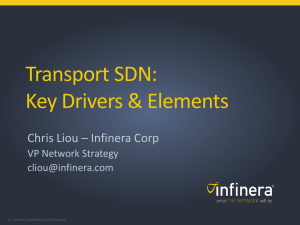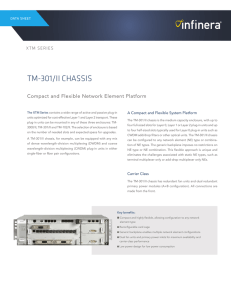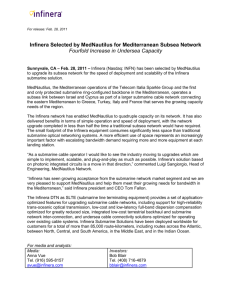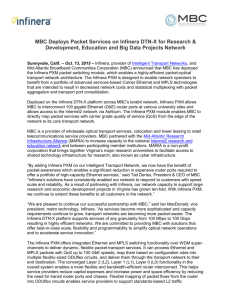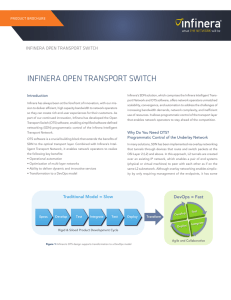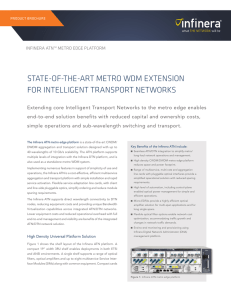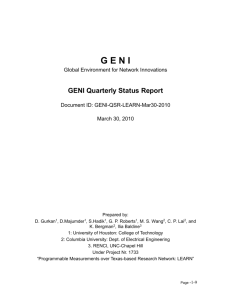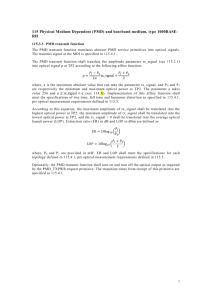INFINERA DEMONSTRATES TRANSOCEANIC 40G SERVICES
advertisement
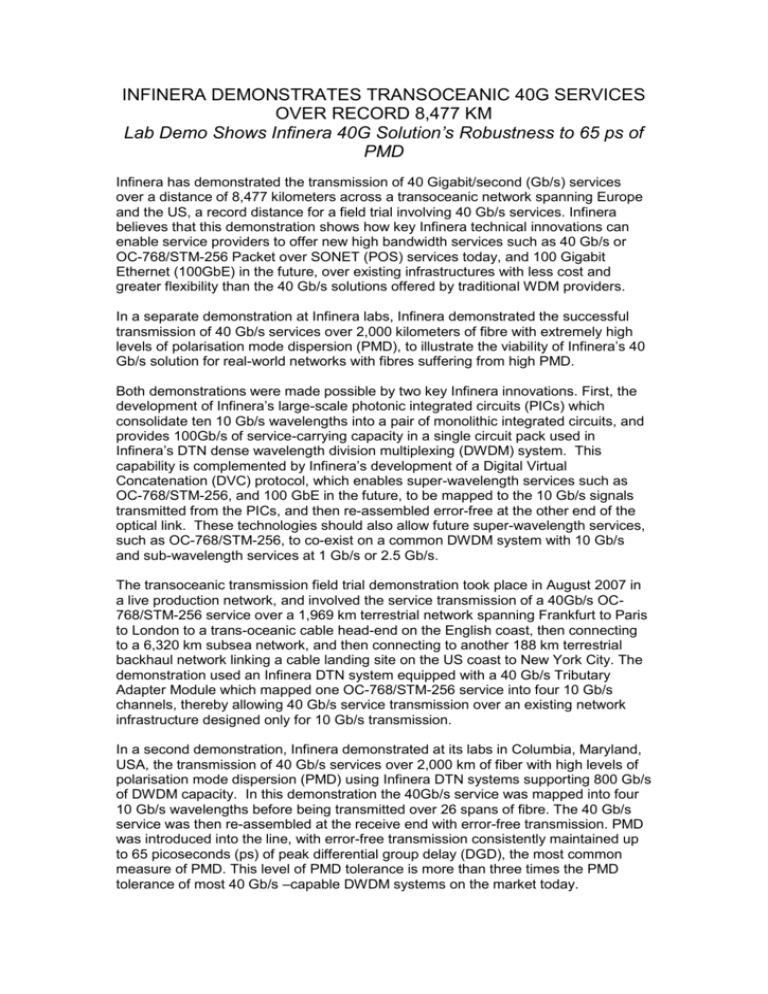
INFINERA DEMONSTRATES TRANSOCEANIC 40G SERVICES OVER RECORD 8,477 KM Lab Demo Shows Infinera 40G Solution’s Robustness to 65 ps of PMD Infinera has demonstrated the transmission of 40 Gigabit/second (Gb/s) services over a distance of 8,477 kilometers across a transoceanic network spanning Europe and the US, a record distance for a field trial involving 40 Gb/s services. Infinera believes that this demonstration shows how key Infinera technical innovations can enable service providers to offer new high bandwidth services such as 40 Gb/s or OC-768/STM-256 Packet over SONET (POS) services today, and 100 Gigabit Ethernet (100GbE) in the future, over existing infrastructures with less cost and greater flexibility than the 40 Gb/s solutions offered by traditional WDM providers. In a separate demonstration at Infinera labs, Infinera demonstrated the successful transmission of 40 Gb/s services over 2,000 kilometers of fibre with extremely high levels of polarisation mode dispersion (PMD), to illustrate the viability of Infinera’s 40 Gb/s solution for real-world networks with fibres suffering from high PMD. Both demonstrations were made possible by two key Infinera innovations. First, the development of Infinera’s large-scale photonic integrated circuits (PICs) which consolidate ten 10 Gb/s wavelengths into a pair of monolithic integrated circuits, and provides 100Gb/s of service-carrying capacity in a single circuit pack used in Infinera’s DTN dense wavelength division multiplexing (DWDM) system. This capability is complemented by Infinera’s development of a Digital Virtual Concatenation (DVC) protocol, which enables super-wavelength services such as OC-768/STM-256, and 100 GbE in the future, to be mapped to the 10 Gb/s signals transmitted from the PICs, and then re-assembled error-free at the other end of the optical link. These technologies should also allow future super-wavelength services, such as OC-768/STM-256, to co-exist on a common DWDM system with 10 Gb/s and sub-wavelength services at 1 Gb/s or 2.5 Gb/s. The transoceanic transmission field trial demonstration took place in August 2007 in a live production network, and involved the service transmission of a 40Gb/s OC768/STM-256 service over a 1,969 km terrestrial network spanning Frankfurt to Paris to London to a trans-oceanic cable head-end on the English coast, then connecting to a 6,320 km subsea network, and then connecting to another 188 km terrestrial backhaul network linking a cable landing site on the US coast to New York City. The demonstration used an Infinera DTN system equipped with a 40 Gb/s Tributary Adapter Module which mapped one OC-768/STM-256 service into four 10 Gb/s channels, thereby allowing 40 Gb/s service transmission over an existing network infrastructure designed only for 10 Gb/s transmission. In a second demonstration, Infinera demonstrated at its labs in Columbia, Maryland, USA, the transmission of 40 Gb/s services over 2,000 km of fiber with high levels of polarisation mode dispersion (PMD) using Infinera DTN systems supporting 800 Gb/s of DWDM capacity. In this demonstration the 40Gb/s service was mapped into four 10 Gb/s wavelengths before being transmitted over 26 spans of fibre. The 40 Gb/s service was then re-assembled at the receive end with error-free transmission. PMD was introduced into the line, with error-free transmission consistently maintained up to 65 picoseconds (ps) of peak differential group delay (DGD), the most common measure of PMD. This level of PMD tolerance is more than three times the PMD tolerance of most 40 Gb/s –capable DWDM systems on the market today. “Bandwidth Virtualisation” The Digital Virtual Concatenation protocol developed by Infinera for carrying a 40 Gb/s service over an infrastructure of 10 Gb/s wavelengths has the potential to enable international IP networks to scale to carry 40 Gb/s router trunks across existing networking infrastructures including terrestrial and transoceanic networks. The DTN System decouples the services carried over the network from the underlying optical networking infrastructure. The 40 Gb/s demonstration is intended to illustrate how this approach can also be applied to allow super-wavelength services to be provisioned, managed, and monitored as single logical circuits, even while the physical transmission is at lower wavelength speeds. This technique, which Infinera calls bandwidth virtualisation, is designed to give service providers the flexibility to carry a broad range of services over today’s infrastructure and with better economics. Infinera also believes that this approach is extensible in the future to 100 Gigabit Ethernet service transport, allowing DTN systems deployed today to support ultra-high bandwidth services in the future. Many service provider networks suffer from high PMD levels on some portions of their fibre plant. This problem is particularly acute for some national carriers in North America, Europe, and Asia where sections of older or legacy fiber do not meet the performance standards of more recently manufactured fiber. We believe that this demonstration shows that the Infinera 40 Gb/s solution can be deployed wherever 10 Gb/s wavelengths can be deployed, enabling service providers to offer 40 Gb/s services today without the need for expensive re-engineering of their fiber plants. By decoupling the available bandwidth, and the optical services sold, from the physical infrastructure carrying that bandwidth, the Infinera vision of bandwidth virtualisation is designed to enable service providers to meet the growth demands of the IP network, and offer a wider variety of profitable services more quickly, flexibly, and without expensive re-engineering or fibre plant characterisation costs. About Infinera Infinera provides Digital Optical Networking systems to telecommunications carriers worldwide. Infinera's systems are unique in their use of a breakthrough semiconductor technology: the Photonic Integrated Circuit (PIC). Infinera's systems and PIC technology are designed to provide optical networks with simpler engineering and operations, faster time-to-service, and more flexible networking. For more information, please visit www.infinera.com. Media contacts: Richard Scarlett / Joe Banks Johnson King 020 7357 7799 InfineraTeam@johnsonking.co.uk
